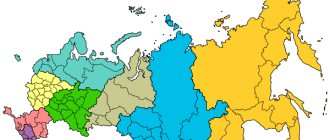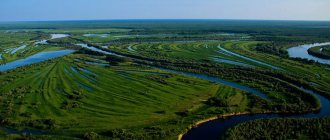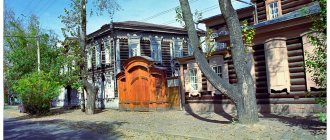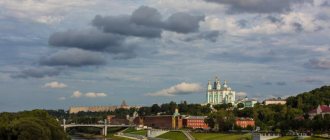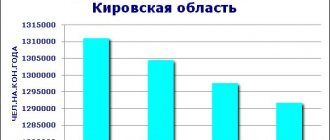Medium-sized cities 20-100 thousand people
Belogorsk (Amur region)
There are also other settlements with this name, see Belogorsk
Population 65,315 (2020). Railway junction at the intersection of the Trans-Siberian Railway with a branch to Blagoveshchensk.
Free
Population 54,017 (2020).
Tynda
Population 33,177 (2020). A large railway junction, the intersection of the Baikal-Amur and Amur-Yakut railways.
Zeya (city)
See also Zeya.
Population 22,984 (2020). The center of electric power industry - the large Zeya hydroelectric power station is located in the city.
Geographical location of the Amur region on the map of the Russian Federation
The Amur region is located in the eastern part of Asia. Its southern part coincides with the border between Russia and China, which runs along the fairway of the river. Amur. Within Russia, the region borders on the following regions:
- in the north - with Yakutia;
- in the east - with the Jewish Autonomous Region and the Khabarovsk Territory;
- in the west - with the Trans-Baikal Territory.
If you look at an online map of the Amur Region with its borders, you can assess its position in relation to the Pacific Ocean. It affects the climate of the region. The eastern part of the region is subject to a monsoon climate, formed by the interaction of the largest ocean and the largest continent.
The northern and western parts of the region are subject to a sharply continental climate with severe frosts in winter, hot summers and little precipitation.
Small towns up to 20 thousand people
Shimanovsk
Population 18,566 people (2020).
Raichikhinsk
Population 16,784 (2020).
Zavitinsk
Population 10,215 (2020).
Skovorodino
Population 8,943 (2020).
Tsiolkovsky
This name has other meanings, see Tsiolkovsky. See also Uglegorsk.
Population 7,188 (2020). A closed city for personnel serving the Vostochny cosmodrome. It received city status in 2015, and it included the former closed urban settlement of Uglegorsk.
Despite the explosive growth of COVID-19, there are no plans to introduce new restrictions in the Amur region
Coronavirus situation
Thus, the situation in the region is currently assessed as difficult, but manageable. According to Kurganova, the region has recorded an explosive increase in incidence over the past week.
— We carry out very close monitoring of the “omicron” circulation. Since the beginning of this year, systematic work has been carried out according to a certain method of collecting samples, which are sent to the institutes of Rospotrebnadzor, said the head of the Rospotrebnadzor department for the Amur region.
The type of virus is determined by sequencing. Similar analyzes are performed by laboratories in Khabarovsk and Novosibirsk. At the same time, only 10% of all positive samples are sent for research, since not all samples are suitable for this due to different concentrations of the virus in them. According to Rospotrebnadzor, “omicron” now dominates in the region - among samples, this particular strain is detected in 40-50% of cases.
“Omicron is detected mainly in Amur residents who returned from abroad (this is Turkey, the Dominican Republic, and the UK), as well as a number of regions of the Russian Federation,” added Olga Kurganova.
She explained that the rate of infection is very high, and the incubation period ranges from one day to three. It follows that introducing a two-week quarantine for contacts is inappropriate. At the same time, the disease in vaccinated people without chronic diseases, as a rule, is milder. It is noted that already on the third day after the onset of symptoms, the patient’s condition improves.
Olga Kurganova noted that, taking into account all these factors, it was decided to reduce the quarantine period for patients to seven days and changed the tactics for contact persons. In addition, if after seven days the infected person has cleared all clinical manifestations of the disease, he is discharged and his sick leave is closed. If the condition improves earlier, then quarantine due to illness can be closed based on the results of repeated PCR testing.
It is important to note that if those in contact with a person sick with coronavirus do not have signs of acute respiratory viral infection, then PCR testing is not carried out, even if they are members of the same family.
Quarantine for schoolchildren
Previously, quarantine was introduced for school classes even if there was one child with a confirmed positive test for Covid. Currently the situation has changed. According to Olga Kurganova, to introduce quarantine it is necessary that at least 20% of students get sick (have an official diagnosis). In this case, the school independently decides to introduce additional restrictions for seven days.
Receiving sick leave
First Deputy Minister of Health of the region Oksana Khimichenko said that in order to open a sick leave, it is necessary to call a doctor at home. The doctor will examine the patient and give an opinion on his condition, on the basis of which a sick leave certificate is issued. If the condition is not critical, then further treatment is carried out remotely through video communication in instant messengers, telephone calls and other means of telemedicine. It is worth noting that sick leaves are now also closed remotely and transmitted to the employer in electronic format.
Oksana Khimichenko also added that in order not to create queues at clinics, patients can call a doctor at home by number 122 or call the clinic reception.
How is sick leave paid?
The manager of the regional branch of the Social Insurance Fund (FSS), Natalya Khrushcheva, said that from January 1, 2022, only electronic certificates of incapacity for work are in use. It follows that the data exchange system between medical organizations and the Social Insurance Fund is as follows: when the sick leave is closed, the information is transferred to the employer. He transfers documents with all the necessary information to the FSS. Within 10 days, the Social Insurance Fund pays for days of incapacity for work according to the account indicated by the employer. At the same time, the transfer of funds to the Mir card occurs almost instantly, unlike other payment systems.
— This mechanism has been worked out. Indeed, somewhere there are complaints against employers who still ask for the usual format in the form of a printed piece of paper on which the number of the certificate of incapacity is indicated. But all this information is in the personal account of the insured person,” explained Natalya Khrushcheva.
"Sanitary shield"
A laboratory center of the third level of security will be built in the Amur region thanks to the federal project “Sanitary Shield”. As Olga Kurganova said, this will allow complex analyzes to be carried out in the region without sending material to other regions of Russia. Similar laboratories will appear in eight more regions of the country.
Work of clinics for both adults and children
Since Monday, Blagoveshchensk clinics have been operating in a new way: dispensary appointments, preventive examinations and “Healthy Child Days” have been stopped. But despite this, at the beginning of the week there were long queues for appointments with therapists and pediatricians.
— On Monday, we were faced with the fact that it was contact people who sent requests for the closure of sick leave, for the closure of quarantine. Everything was very unclear. People are used to being given paper sick leaves. We carried out information work with patients, we even went to clinics and talked to people in queues. There was a very large influx of children’s clinics because children’s groups were in quarantine. We provided information through all our resources that you do not need to come for a sick leave or a certificate for your child; The process will be established remotely with schools, employers and the Social Insurance Fund. But some people still came to the clinics,” Oksana Khimichenko commented on the situation.
She explained that now there is no need to appear in person for an appointment, but patients still want to communicate with the doctor in person. At the same time, by Tuesday the influx of visitors to clinics had subsided, and institutions were returning to normal operation.
QR codes for antibodies
People who have antibodies to coronavirus, but were treated unofficially, can now receive QR codes. The corresponding resolution was published on the official legal information portal.
As Oksana Khimichenko explained, this system has not yet been worked out: a decision will be made on which laboratories will have the right to conduct such research. After this, people with antibodies will be given a QR code.
Coronavirus restrictions
Olga Kurganova, head of the Rospotrebnadzor department for the Amur region, assured that there are no plans to introduce additional restrictions due to the explosive growth in the incidence of coronavirus. It is enough to strictly follow those that are already in effect.
Urban settlements
- Magdagachi
Population 9,895 (2020).
- Progress
Population 9,517 (2020).
- Seryshevo
Population 9,438 (2020).
- Arhara
Population 8,508 (2020).
- Novobureysky
Population 6,688 (2020).
- Fevralsk
Population 4,560 people (2020).
- Erofey Pavlovich
Population 4,438 (2020).
- Talakan
Population 4,139 (2020).
- Bureya
Population 4,021 (2020).
- Urusha
Population 3,262 (2020).
- Ushumun
Population 1,899 (2020).
- Novoraichikhinsk
Population 1,842 people (2020).
- Sivaki
Population 1,568 people (2020).
- Ekimchan
Population 986 people (2020).
- Tokur
Population 816 people (2020).
Cities[ | ]
Among the 10 cities, the following stand out[1][2][3]:
- 7 cities corresponding to the category of regional subordination ( highlighted in orange
), which form urban districts within the framework of the organization of local self-government, - highlighted in gray
in the list - forms a city district within the framework of the organization of local self-government; - 2 cities corresponding to the category of district subordination (within the framework of the organization of local self-government they are included in the corresponding municipal district and municipal district).
| № | Name | district / mun. district/city of regional subordination/ZATO[5] | municipal district/mun./city district[6] | population (persons) | founding/first mention | city status | coat of arms |
| 1 | Belogorsk | Belogorsk | Belogorsk, GO | ↘64 502[4] | 1860 | 1926 | |
| 2 | Blagoveshchensk | Blagoveshchensk | Blagoveshchensk, GO | ↘225 757[4] | 1856 | 1858 | |
| 3 | Zavitinsk | Zavitinsky municipal district | Zavitinsky municipal district | ↘9957[4] | 1906 | 1954 | |
| 4 | Zeya | Zeya | Zeya, GO | ↘22 714[4] | 1879 | 1906 | |
| 5 | Raichikhinsk | Raichikhinsk | Raichikhinsk, GO | ↘16 479[4] | 1932 | 1944 | |
| 6 | Free | Free | Svobodny, GO | ↘52 918[4] | 1912 | 1912 | |
| 7 | Skovorodino | Skovorodinsky district | Skovorodino municipal district | ↘8745[4] | 1908 | 1927 | |
| 8 | Tynda | Tynda | Tynda, GO | ↘32 894[4] | 1907 | 1975 | |
| 9 | Tsiolkovsky | Tsiolkovsky (ZATO) | Tsiolkovsky (ZATO), GO | ↗7193[4] | 1961 | 2015 | |
| 10 | Shimanovsk | Shimanovsk | Shimanovsk, GO | ↘18 513[4] | 1910 | 1950 |
see also
- Amur region
- Symbols and landmarks of the Amur region
- Cities of Russia
| [ + ] Cities by regions of Russia | |
| Cities of the North-West (NWFD) | St. Petersburg (and its cities) • Leningrad region (historical Staraya Ladoga) • Arkhangelsk region • Vologda region • Kaliningrad region • Karelia • Komi • Murmansk region • Nenets Autonomous Okrug • Pskov region |
| Cities of the Volga region (Volga Federal District) | Bashkortostan • Volgograd region • Kalmykia • Kirov region • Mari El • Mordovia • Nizhny Novgorod region • Orenburg region • Penza region • Perm region • Samara region • Saratov region • Tatarstan • Udmurtia • Ulyanovsk region • Chuvashia |
| Cities of Southern Russia (SFD) | Sevastopol (including Inkerman) • Republic of Crimea • Adygea • Astrakhan region • Krasnodar region • Rostov region |
| Cities of the North Caucasus (NCFD) | Dagestan • Ingushetia • Kabardino-Balkaria • Karachay-Cherkessia • North Ossetia - Alania • Stavropol Territory • Chechen Republic |
| Cities of the Urals (Ural Federal District) | Kurgan region • Sverdlovsk region • Tyumen region • Khanty-Mansi Autonomous Okrug - Yugra • Chelyabinsk region • Yamalo-Nenets Autonomous Okrug |
| Cities of Siberia (Siberian Federal District) | Altai Republic • Altai Territory • Irkutsk Region • Kemerovo Region • Krasnoyarsk Region • Novgorod Region • Novosibirsk Region • Omsk Region • Tomsk Region • Tyva • Khakassia |
| Cities of the Far East (FEFD) | Amur Region • Buryatia • Jewish Autonomous Region • Trans-Baikal Territory • Kamchatka Territory • Magadan Region • Primorsky Territory • Sakha (Yakutia) • Sakhalin Region • Khabarovsk Territory • Chukotka Autonomous Region |
| see also | Cities of the DPR, LPR, Transnistria, South Ossetia • Regions of Russia • Cities of Russia |
Natural features
The geographical location and climate of the region influence the natural zonation. The satellite map gives an idea of the relief and vegetation of the region.
The region is divided into four physiographic regions:
- Stanovoy (far north with spurs of the Stanovoy Range)
- mountain systems of the north (Tukuringra, Soktohan ranges, etc.);
- Zeya-Bureya Plain (a flat area located between the Bureya and Amur rivers and the spurs of the Lesser Khingan on the border with the Jewish Autonomous Region);
- Amur-Zeya Plain (territory located between the Zeya, Bureya and Amur rivers).
The mountainous part of the region is covered with coniferous forests with a predominance of larch, spruce and fir. On the mountain plateaus and in the lowlands of the northern part, tundra communities have formed on permafrost.
The southeastern part of the region is mostly plowed. On the outskirts of its eastern part, relict coniferous-deciduous forests with the dominance of Mongolian oak, flat-leaved and Daurian birch, Amur velvet, Manchurian ash, and Korean cedar have been preserved.
Urban settlements[ | ]
Among the 15 urban-type settlements (working settlements) the following stand out[1][2][3]:
- 1 urban settlement corresponding to the category of regional subordination - highlighted in orange
- forms a city district within the framework of the organization of local self-government; - 1 urban-type settlement subordinate to an urban-type settlement of regional subordination,
- 13 urban settlements as part of districts (within the framework of the organization of local self-government they are included in the corresponding municipal districts or municipal districts).
| № | Name | district / town of regional subordination[5] | municipal district/mun./city district[6] | population (persons) |
| 1 | Arhara | Arkharinsky district | Arkharinsky municipal district | ↘8437[4] |
| 2 | Bureya | Bureya municipal district | Bureya municipal district | ↘3942[4] |
| 3 | Erofey Pavlovich | Skovorodinsky district | Skovorodino municipal district | ↘4368[4] |
| 4 | Magdagachi | Magdagachinsky district | Magdagachinsky municipal district | ↘9804[4] |
| 5 | Novobureysky | Bureya district | Bureya municipal district | ↘6572[4] |
| 6 | Novoraichikhinsk | Progress | r.p. Progress, GO | ↘1804[4] |
| 7 | Progress | Progress | r.p. Progress, GO | ↘9383[4] |
| 8 | Seryshevo | Seryshevsky district | Seryshevsky municipal district | ↗9575[4] |
| 9 | Sivaki | Magdagachinsky district | Magdagachinsky municipal district | ↘1523[4] |
| 10 | Talakan | Bureya municipal district | Bureya municipal district | ↘4046[4] |
| 11 | Tokur | Selemdzhinsky district | Selemdzhinsky municipal district | ↘796[4] |
| 12 | Urusha | Skovorodinsky district | Skovorodino municipal district | ↘3245[4] |
| 13 | Ushumun | Magdagachinsky district | Magdagachinsky municipal district | ↘1859[4] |
| 14 | Fevralsk | Selemdzhinsky district | Selemdzhinsky municipal district | ↘4500[4] |
| 15 | Ekimchan | Selemdzhinsky district | Selemdzhinsky municipal district | ↘965[4] |
Former town[ | ]
- Berezovka has been a town since 1981. Converted to a rural settlement in 1991.
- Varvarovka - transformed into a rural settlement in 1996.
- Vozzhaevka has been a town since 1980. Converted to a rural settlement in 1995.
- Gluboky - transformed into a rural settlement in 1968.
- Ekaterinoslavka has been a town since 1964. Converted to a rural settlement in 1991.
- Zavitaya is a town since 1936. Transformed into the city of Zavitinsk in 1954.
- Zlatoustovsk has been a town since 1942. Transformed into a rural settlement in 2010[7].
- Kivdinsky has been a town since 1929. Converted to a rural settlement in 1982.
- Kirovsky has been a town since 1940. Converted to a rural settlement in 1968.
- Koboldo has been a town since 1958. Converted to a rural settlement in 2012.
- Lukachek has been a town since 1942. Converted to a rural settlement in 1974.
- Maisky has been a town since 1939. Converted to a rural settlement in 1997.
- Nevers has been a town since 1934. Transformed into a rural settlement in 2001[8].
- Ogodzha has been a town since 1958. Converted to a rural settlement in 2012.
- Oktyabrsky has been a town since 1939. Converted to a rural settlement in 1995.
- Poyarkovo has been a town since 1963. Converted to a rural settlement in 1992.
- Raichikhinsk has been a town since 1934. Incorporated into a city in 1944.
- Solovyovsk has been a town since 1934. Converted to a rural settlement in 1996.
- Srednebelaya - town since 1981. Converted to a rural settlement in 1991.
- Srednyaya Nyukzha has been a town since 1933. Until 1938 it was called Blyukherovsk. Converted to a rural settlement in the 1950s.
- Stoiba has been a town since 1942. Transformed into a rural settlement in 2008[9].
- Taldan has been a town since 1950. Transformed into a rural settlement in 2001[8].
- Takhtamygda has been a town since 1957. Transformed into a rural settlement in 2001[8].
- Tygda has been a town since 1958. Converted to a rural settlement in 1993.
- Tyndinsky has been a town since 1941. Transformed into the city of Tynda in 1975.
- Shimanovsky has been a town since 1929. Transformed into the city of Shimanovsk in 1950.
- Shiroky - converted into a rural settlement in 2009.
- Uglegorsk - transformed into the city of Tsiolkovsky in 2015[10][11].
- Yasny - transformed into a rural settlement in 1979.


